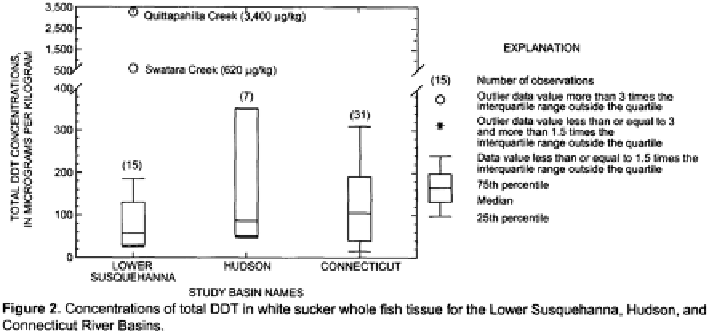Environmental Engineering Reference
In-Depth Information
Fig. 11
Total DDT in white sucker tissue from Northeastern United States. Figure 2 in Bilger
et al. (
1999
) courtesy of the U.S. Geological Survey
multi-species fi sh sampling of the lower Susquehanna River basin by Bilger et al.
(
1999
) in 1992 found median residues of 0.250 ppm of total DDT. Variability
between sites was very high as shown in results for white suckers collected from the
Susquehanna, Hudson and Connecticut River Basins (Fig.
11
).
The overall trend for DDT in fi sh residues in the 1970s and 1980s was a steady
decline, although hot spots were clearly evident. If these hotspots are sources of
food for ospreys and are missed in fi sh surveys, then the residue exposures may be
greatly underestimated, resulting in an overestimate of biomagnifi cation from fi sh
to osprey egg.
Steidl et al. (
1991a
,
b
) published two papers on osprey reproduction in three
regions of southern New Jersey. The three locations were the more polluted
Delaware Bay, the less polluted Atlantic Coast and an intermediate location along
the Maurice River that fl ows into the lower Delaware Bay. Eggs were collected in
1985-1989. The authors noted that average fi sh residue of total DDT in the Delaware
River was 0.88 ppm in 1984. Total DDT residues in eggs were low with the highest
levels in Delaware Bay as shown in Table
16
. Eggshell thickness was negatively
correlated to DDE levels in the eggs as can be judged from Tables
16
and
17
.
Apparently, eggs with shells thinned near to or at 15% had a greater probability
of breaking, contributing to the lower productivity observed in Delaware Bay com-
pared to the other two locations as shown in Table
18
.
Analysis of DDT residues in prey fi sh revealed the following results as shown in
Table
19
.
One should keep in mind that these fi sh samples were not scraps from the osprey
nests but fi sh caught locally in the breeding grounds. Since ospreys often feed up the
rivers from their breeding grounds, more contaminated fi sh may well have been
consumed. Viscera were removed from whole fi sh prior to analysis. Viscera would
contain liver, some adipose tissue and other organs that would be expected to have

Search WWH ::

Custom Search